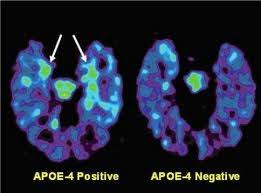One of the most common things you hear in relation to Alzheimer’s is “Oh all the men in my family get it, so I’m going to get it” or “It’s not in my family so I am not concerned.” The question here is how straightforward is Alzheimer’s that you can just predict it based on family history? The answer is more complex than you would think.

For a second let us only look at the APOE gene and the heritability of Alzheimer’s. The APOE gene is an apolipoprotein E protein located on chromosome 19 and is responsible for synthesizing a protein that transports cholesterol and other fat types throughout the bloodstream. This APOE gene has three types: e2, e3, and e4. Specifically, the APOE-e4 type gene is the only one that has a correlation to the development of Alzheimer’s. When you receive one copy of the -e4 gene from one parent, you are at an increased risk for developing Alzheimer’s. If you have inherited two copies of the -e4 gene, you are at an even higher risk, but not at certainty to the development of the disease. Approximately 20-30% of US individuals have one copy of the gene, whereas only 2% have two copies.
However, one thing this theory fails to consider is the penetrance of the genes, or the expression of the gene. Someone who has two copies of the -e4 gene with a low penetrance are probably at a decreased risk for developing Alzheimer’s. Many psychologists actually discourage genetic testing for this gene because most testing does not account for penetrance or other factors that would increase your risk, such as sustaining concussions or Type 2 Diabetes. Also, most commonly the inherited form of Alzheimer’s that is inherited is late-onset, so many researchers wonder what there is to stress about now if the disease won’t start showing until you are 70-80 years old.
Wait, did I just say Type 2 Diabetes increases your risk for developing Alzheimer’s? Why yes I did. One review study examined the role of insulin signaling on the development of components of Alzheimer’s, such as neuroinflammation and Ab plaques in the brain. When a receptor (TNF-a) causes inflammation in the brain it begins a cascade of insulin resistance by activating PKR which causes IRS 1 to be inhibited. When IRS 1 is inhibited, insulin is not being properly released to regulate other events, such as autophagy, synaptic plasticity, and cell cycle events. On top of TNF-a mediated inflammation, unchecked PTP1B activity initiates inflammation further and downregulates BDNF activity reducing synaptic plasticity. Deregulated mTOR signaling also is involved in retro inhibition of IRS-1 which can lead to further dysregulation of autophagy and insulin resistance. Lastly aberrant ganglioside metabolism promotes the Ab plaque aggregation and impairs insulin receptor function.
All the above information is in relation to Alzheimer’s, but all the above information is also seen to some degree in Type 2 Diabetes. Now, Type 2 Diabetes is primarily correlated to obesity and an unhealthy diet. Would eating healthy not only reduce your risk of Type 2 diabetes but also Alzheimer’s even if you have copies of the APOEe-4 gene?
Photo Sourced From: https://genesandinheritancr.wordpress.com/2011/09/20/inheriting-the-apoe-e4-gene-and-what-it-means/
